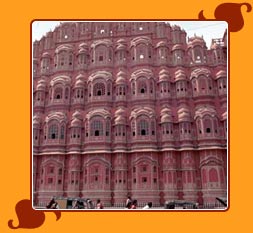The Hawa Mahal is counted amongst the most gorgeous and
captivating piece of work by the Rajput rulers. The Rajputs were strictly
traditional and did not wish their women folk to be seen in public.

The
Rajputs women were themselves immensely particular about their dignity and
self respect hence, they did not prefer to come out in open with the common
public and strangers. However, this did not deter them from taking interest
in the proceedings of the court and other happenings of the world. Infact,
the court rooms had special chambers for the women from where they could
watch the day to day proceedings. And when they desired to have a look at
the happenings of the outer world, a structure like Hawa Mahal had to be
built.
So, Hawa Mahal was a window to the outer world for the
royal ladies and the Rajput ruler who ordered its construction in the year
1799 was Sawai Raja Pratap Singh. The Hawa Mahal is an elemental part of the
City Palace complex of Jaipur, yet it stands away from it and commands its
own identity from the passerby. Standing on one of the main streets of
Jaipur, the Hawa Mahal still quietly monitors the affairs of the city
dwellers and welcomes anyone who comes to inspect it.
Architecture
of Hawa Mahal This five storeyed pyramid structure was designed by
Lal Chand Ustad who dedicated his work to Lord Krishna and Radha. The
pyramid shape of the Mahal gives it an appearance of the crown that adorned
the head of Lord Krishna. The Mahal stands on a podium and is fifty feet
high. The thickness, however, is less than even a foot.
The
entrance is through the City Palace from where doors open into a commodious
courtyard with double storeyed buildings covering three sides. The building
today houses an Archaeological Museum. The upper two storeys have just a
single room. There are no stairs to reach the upper floors. Rather, there
are ramps meant for carrying the palanquin of the royal ladies.
The
entire structure is made up of 953 small casements each with small lattice
worked pink window, small balconies and arched roofs with hanging cornices.
Cool breezes enter through the window and keep the inner atmosphere
extremely pleasant and airy. Visitors will be surprised to notice that in
sharp contrast to its rich exteriors, the interiors of the Hawa Mahal is
strikingly simple. However, it is from here that visitors can have some of
the finest views of the modern city of Jaipur. A remarkable Rajputana
structure worth visiting.
Hawa Mahal - Rajput Style
Of Architecture Among all the states of erstwhile princely India,
Rajputana (now Rajasthan) is undoubtedly one of the most colorful. Despite
their time-consuming preoccupation with war, the Rajputs, at all periods of
their history, have been patrons of art and architecture. They were great
builders, and their forts and palaces, built for reasons of security,
residence and leisure of the Maharajas and their women, are not only
impressive but a very important part of Rajasthan's cultural and
architectural heritage. A study of Rajput monuments shows that it was
strongly influenced by Mughal architecture.
However, the Rajputs
adapted and used Mughals styles so tastefully in their buildings that it led
to the development of a distinct architectural style of great sophistication
and imaginative invention. The Rajput style, on one hand, has traditional
Hindu elements like the chhatris (small domed canopies, supported by
pillars), fluted pillars, lotus and floral patterns, etc., and, on the other
hand, it has elements like stone inlay work and arches, which are reflective
of the Islamic style of architecture.
Hawa Mahal -
Monument Of IndiaThe city of Jaipur reflects a clever amalgamation
of the Rajput and Mughal styles, which has given this city a unique
character. Being close to Delhi and Agra, and the fact that its rulers were
powerful members of the Mughal durbar (court), ensured that its rulers kept
the special Mughal touches of filigreeing marble and sandstone alive.
Fresco
painting and inlaid mirror work has also been used extensively to create a
fantasy world of color and richness in the midst of bleak surroundings. This
love for decoration was not confined to the royal houses but filtered down
to the common man as well. This is apparent when one takes a walk down the
broad streets of this delightful city. Jaipur was founded in 1727 by one of
the greatest rulers of the Kachhawaha clan, the astronomer-king Sawai Jai
Singh II (1699-1743), and designed by the brilliant architect Vidhyadhar
Bhattacharya. Later rulers made their own contributions to the city by
building more palaces and temples during their reign.
Designed in
accordance with ancient Hindu treatise on architecture, the Shilpa Shastra,
Jaipur follows a grid system and is encircled by a fortified wall. The main
palace lies in the heart of the city and occupies the space of the central
grid. The rest of the grids were cut across neatly by wide lanes, which
divided the area into tidy, well-laid rectangles of commercial and
residential use. Most places of interest are located mainly in the walled
city. The City Palace complex is the most important landmark of Jaipur and
has a number of interesting buildings within its precincts.






